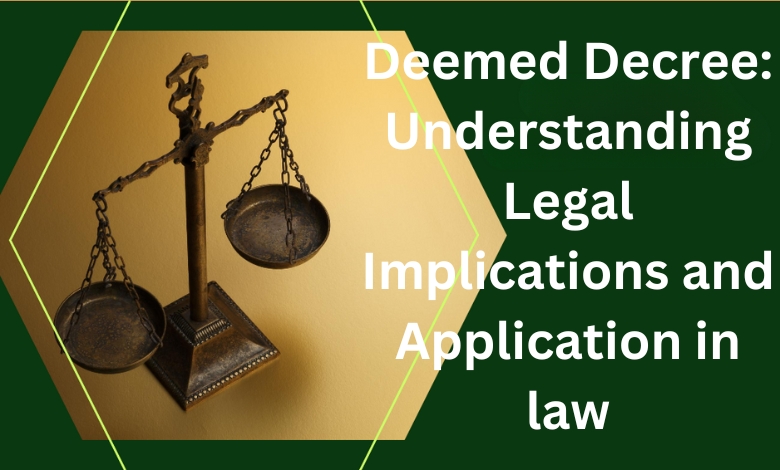Deemed Decree in law is an automatically granted court order, expediting legal processes and ensuring justice. Ladies and gentlemen, legal aficionados and curious minds alike, gather ’round as we embark on a journey to demystify an enigmatic concept in the realm of law – Deemed Decree! Brace yourselves for a captivating exploration into the depths of its origin, application, and implications.
In this intriguing blog post, we will delve deep into the intricacies of Deemed Decrees. What exactly is it? How did it come about? And most importantly, what are its legal ramifications? Join us as we unravel these questions and shed light on real-life case studies that will leave you captivated until the very end.
So fasten your seatbelts, grab your favourite beverage (a cuppa or maybe even some sparkling water), and get ready to immerse yourself in this fascinating world where justice meets interpretation.
Hints of Content
What is a Deemed Decree?
In the legal realm, a deemed decree refers to a court order that is deemed to have been granted even without the formal issuance of such an order. It may sound like a peculiar concept, but it plays an important role in ensuring justice and expediting legal processes.
Essentially, a deemed decree comes into play when certain conditions or requirements have been met, allowing the court to bypass further proceedings and treat the matter as if a formal decree has already been entered. This can save time and resources for both parties involved in a legal dispute.
The concept of deemed decrees originated from the need to address situations where delays or technicalities could hinder justice. By deeming a decree to be in effect, courts are able to provide timely resolutions while still maintaining fairness and due process.
There are various types of deemed decrees depending on the jurisdiction and specific circumstances. Some common examples include default judgments (when one party fails to respond or appear), summary judgments (where there is no genuine issue of material fact), and consent decrees (agreements between parties).
The application process for obtaining a deemed decree involves following proper legal procedures. The party seeking such an order must present evidence supporting their claim or defence, demonstrate compliance with relevant rules or statutes, and satisfy any other requirements outlined by law.
Several factors can influence whether or not a court will grant a request for a deemed decree. These may include adherence to procedural rules, timeliness in filing documents, presentation of compelling evidence, lack of opposition from opposing parties, and overall merit of the claims being made.
History and Origin of Deemed Decree
The history and origin of deemed decrees can be traced back to ancient legal systems. While the concept may have evolved over time, its roots can be found in early civilizations were rulers and authorities established laws to maintain order in their societies.
In many ancient cultures, including those of Mesopotamia and Egypt, decrees were used as a means of issuing commands or directives from the ruling class. These decrees carried significant weight and were considered legally binding for all citizens.
As societies developed more complex legal systems, the concept of a “deemed decree” emerged. This term refers to a decree that is deemed or considered valid by virtue of certain circumstances or conditions being met.
For example, in common law jurisdictions like the United States and England, courts may issue deemed orders when one party fails to appear before them. In this context, a court’s decision is treated as if it were an actual decree even though it was made without full participation from all parties involved.
In civil law countries such as France and Germany, deemed decrees are known as “judgments by default.” These occur when one party does not respond to a lawsuit within the specified time period. The court then issues a judgement based on the evidence presented by the plaintiff alone.
The use of deemed decrees has been controversial at times due to concerns about fairness and due process. However, they continue to play an important role in modern legal systems by allowing for swift resolution when one party fails to participate adequately in legal proceedings.
Types of Deemed Decrees
When it comes to legal matters, understanding the different types of deemed decrees is crucial. These decrees are court orders that are treated as if they were regular legislative acts. They carry the same weight and authority, but with some key distinctions.
One type of deemed decree is known as a “procedural decree.” This type of decree deals with the rules and procedures that govern how a case will be handled in court. For example, a procedural decree may determine deadlines for submitting evidence or outline the steps involved in mediation or arbitration.
Another type of deemed decree is called a “substantive decree.” Unlike procedural decrees, which focus on process, substantive decrees address the actual rights and obligations of the parties involved in a legal dispute. These decrees can have far-reaching effects on individuals’ lives and businesses.
Additionally, there are “default decrees” that come into play when one party fails to respond or appear in court. In such cases, the judge may issue a default judgement against them based on the other party’s claims and evidence. These default judgments are deemed enforceable even though one party did not actively participate in proceedings.
Legal Process and Implications of a Deemed Decree
When it comes to legal matters, understanding the process and implications of a deemed decree is crucial. A deemed decree refers to a court order that is automatically granted in favour of one party due to the failure of the opposing party to take action or respond within a specified timeframe.
The legal process surrounding a deemed decree starts when one party files a complaint or initiates legal proceedings against another. The defendant then has a certain period within which they must respond or defend themselves. If they fail to do so, the court may issue a deemed decree in favour of the claimant.
The implications of such a decree can be significant for both parties involved. For the claimant, it means that their claims are accepted by default without any further arguments from the defendant. This can result in favourable outcomes for them, including financial compensation or other forms of relief as sought in their complaint.
On the other hand, for defendants who have failed to respond or take appropriate action within the prescribed time limit, being subject to a deemed decree can have serious consequences. It essentially means that they lose their opportunity to present their side of the case and contest any allegations made against them.
Factors influencing whether a deemed decree will be issued include jurisdiction-specific rules and regulations governing civil procedures, along with individual circumstances surrounding each case. The court will consider factors such as proper service of notice upon all relevant parties and adherence to specific deadlines before deciding on issuing such an order.
Factors Influencing the Application of a Deemed Decree
Several factors can influence the application of a deemed decree in legal proceedings. These factors play an important role in determining whether a court will consider applying this type of judicial order to resolve disputes.
1. Jurisdiction:
The jurisdiction in which the case is being heard can significantly impact the application of a deemed decree. Different jurisdictions may have varying laws and regulations regarding its use, making it more or less likely to be employed.
2. Nature and Complexity of the Dispute:
The nature and complexity of the dispute can also affect whether a court chooses to employ a deemed decree. In straightforward cases where there is little ambiguity or room for interpretation, courts may be more inclined to utilise this mechanism.
3. Availability of Evidence:
The availability and quality of evidence presented by both parties can sway the decision on whether to apply a deemed decree. If one party provides compelling evidence that supports their claim, it may increase the likelihood that such an order would be considered.
4. Legal Precedents:
Past legal precedents set by similar cases can heavily influence how courts approach applications for deemed decrees. If there are established precedents supporting its use in comparable circumstances, courts may be more inclined to rule accordingly.
5. Consent from Both Parties:
In some instances, both parties involved in the dispute must agree on using a deemed decree for it to become applicable. This consent is crucial as it demonstrates mutual understanding and acceptance of this alternative resolution method.
It’s essential when dealing with legal matters involving potential application for deem decrees to consult with experienced lawyers who specialise in resolving disputes through these means given their intricate nature.
Case Studies: Real-life Examples of Deemed Decrees in Action
In the world of law, deemed decrees have become a significant tool for resolving complicated legal matters. Let’s take a closer look at some real-life examples where deemed decrees were applied.
One notable case involved a construction company that failed to deliver a completed project within the agreed-upon timeframe. As a result, the client filed a lawsuit seeking damages and termination of contract. The court, after carefully considering all evidence, issued a deemed decree ordering the construction company to pay compensation for breach of contract and complete the project within an extended deadline.
Another instance involved an insurance claim dispute between an individual and their insurance provider. The policyholder had incurred substantial medical expenses following an accident but faced difficulty in obtaining reimbursement from their insurer. Through litigation, it was established that the insurer had wrongfully denied coverage without proper investigation. Consequently, the court employed a deemed decree to oblige the insurer to reimburse all medical expenses as mandated by policy terms.
How to Handle a Deemed Decree As a Defendant or Claimant
When facing a deemed decree as either a defendant or claimant, it is crucial to approach the situation with careful consideration and strategic planning. Here are some key steps to guide you through the process:
1. Understand the grounds:
Take the time to thoroughly understand the basis on which the deemed decree has been issued against you. Review all relevant legal documents and consult with an experienced attorney if needed.
2. Gather evidence:
Collect any supporting evidence that may help in your defence or claim. This could include documents, witness statements, photographs, or expert opinions.
3. Assess your options:
Evaluate whether it would be beneficial to challenge the deemed decree or negotiate a settlement with the opposing party. Consider potential costs, risks, and potential outcomes when making this decision.
4. Seek legal advice:
Engage an experienced lawyer who specialises in handling cases involving deemed decrees. They can provide expert guidance tailored to your specific circumstances and ensure you have proper representation throughout the process.
5.Draft a strong response:
If challenging the deemed decree, prepare a well-crafted response outlining your arguments and supporting evidence clearly and concisely.
6.Pursue alternative dispute resolution (ADR):
Depending on local regulations, explore ADR mechanisms such as mediation or arbitration as alternatives to litigation. These processes can often lead to faster resolutions while maintaining confidentiality.
7.Attend court hearings diligently:
If required by law, attend all court hearings related to your case promptly and preparedly following any orders given by authorities during those procedures
Remember that every case is unique; therefore,the above steps may need adjustments accordingly.
CONCLUSION
The legal process surrounding deemed decrees is complex, but by familiarising ourselves with it, we are better equipped to navigate potential legal challenges. Factors such as jurisdictional rules, evidentiary requirements, and procedural considerations all play a role in determining whether a situation qualifies for treatment as a deemed decree.
Real-life case studies have further highlighted how deemed decrees can impact both defendants and claimants alike. These examples serve as cautionary tales and underscore the importance of proactive measures when dealing with potential claims or disputes that may result in a deemed decree.



